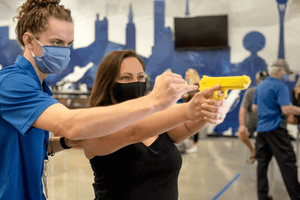Introduction
What is marksmanship? At 45 Blast, we believe it’s more than just hitting your target. It’s about discipline, safety, and a strong sense of purpose.
Marksmanship is all about being a competent shooter. Whether you’re into competitive shooting or carry for self-defense, strong marksmanship skills go beyond just knowing how to fire a gun. They show that you can be trusted with firearms.
Trust, safety, legacy, and accuracy—these are the cornerstones of good marksmanship.
So, why is pistol marksmanship the most important? The answer goes beyond technical skills. Handgun marksmanship si important because your pistol is often your first line of action. Even if you’re a rifle shooter, in diverse scenarios you’re most likely to have your pistol at hand, whether you’re at the range or in a critical situation.
The better prepared you are, the better off you’ll be. So, let’s dive into what marksmanship is, from the basics all the way to becoming a true expert.
Understanding Marksmanship
What is marksmanship? At its core, marksmanship is the skill of shooting accurately and consistently. But this is way more than just pulling the trigger. Being a good marksman means you can handle your gun correctly, manage stress effectively, and follow all rules and protocols.
These principles help you be better prepared, no matter the situation. Whether you’re aiming for the bullseye at a competition or ensuring your safety in a self-defense scenario, marksmanship is the foundation of all shooting sports and activities.
To better understand what marksmanship is, let’s take the 3 levels used in the U.S. military:
- Marksman: The entry-level, where a shooter demonstrates basic competence and accuracy.
- Sharpshooter: A step above. Being a sharpshooter requires a higher degree of precision and control.
- Expert: The pinnacle of military marksmanship, where shooters consistently hit their targets with near-perfect accuracy.
These three U.S. military marksmanship levels have set the standard for other gun community initiatives. For instance, the Civilian Marksmanship Program (CMP) in Utah promotes training events and awards, even with plans to build a shooting range in Payson.
Programs like these offer civilians the chance to refine their shooting skills and get involved. Also, they offer a great opportunity to learn more about the importance of marksmanship in U.S. history and its role in the development of our country.
Now, let’s have a look now at what makes great marksmen.
Fundamental Principles
Shooting practice makes the expert marksman. These are the essential principles that every competent shooter needs to understand and perfect:
Proper Stance and Body Alignment
Your stance and body alignment are the bedrock of accurate shooting. A proper stance provides stability and balance, allowing you to control recoil and maintain accuracy.
What makes a good shooting stance? Let’s break this down:
- Start by keeping your feet shoulder-width apart, with your weight evenly distributed.
- Your knees should be slightly bent, and your body should lean forward slightly to better manage recoil.
Especially for beginners, practicing this stance until it becomes second nature is essential. If you want to learn more about getting a solid, grounded base, check out our blog post on how to shoot a handgun accurately.
Grip and Hold Techniques
Your grip is crucial because it directly affects recoil control, accuracy, and overall handling of your firearm. Now, how do you develop a master grip? The answer is right at your fingertips:
First, ensure that your dominant hand wraps firmly around the pistol grip, with your fingers applying equal pressure. Your support hand should cover as much of the grip as possible, with your fingers wrapping around the front of the dominant hand. The thumbs should point forward along the side of the frame, creating a secure and stable hold.
Sight Alignment and Picture
Sure, you already know this: When sight alignment and sight picture are in sync, you’re set up for a successful shot. Now, how do you adjust your sights?
For correct sight alignment, adjust the front sight with the rear sight so that they are level and centered. The sight picture adds your target into the equation, with the aligned sights placed on the intended point of impact.
If you want to learn more about aiming and sights, check out our Minute of Angle (MOA) article, with everything you need to know about making those precise adjustments for longer-range shots.
Trigger Control and Follow-Through
Trigger control is about applying smooth, consistent pressure on the trigger until the shot breaks. This helps maintain your sight picture and prevents jerking the gun, which can throw off your shot.
Also, follow-through is another fundamental for marksmanship. What you do immediately after the shot is fired helps you keep your sights aligned and your focus on the target. Training follow-through is about developing consistency and accuracy, ensuring that each shot is as precise as the last.
Breath Control for Accuracy
Marksmanship should be even in the way you breathe, as this directly impacts on your ability to steady your aim and control your shots. Here are two breath control techniques for shooting:
Technique 1: Natural Breathing
As you breathe naturally, there’s a brief pause after you exhale and before you inhale again. This is the moment when your body is most still, and your heart rate is at its lowest. To maximize accuracy, try to fire your shots during this pause, after your lungs have released air.
Technique 2: Hold Your Breath and Shoot
In certain situations, holding your breath can give you the stability you need to make a precise shot. After taking a deep breath, hold it gently while you aim and fire. However, it’s important to practice the breath and hold method, to avoid tensing up.
Practical Shooting Drills

Practice—and patience—make the master, as they say. These drills are designed to take your range routine to the next level, developing precision, control, and efficiency under different conditions.
The goal of marksmanship drills is to progress from fundamentals to more complex shooting scenarios, honing your skills step by step.
Trigger Finger Zero
The Trigger Finger Zero drill is all about mastering trigger control. The goal is to fire a shot without moving the sights off target. Start by dry firing your pistol, ensuring that your sights stay perfectly still as you pull the trigger.
This drill helps you develop a smooth, consistent trigger pull, minimizing the chances of jerking the trigger and throwing off your shot.
Presentation from Retention
Next on our marksmanship drills list is a pistol draw drill. The Presentation from Retention exercise is designed to enhance your ability to draw and fire quickly from a close retention position.
Start with your firearm holstered and simulate a defensive scenario where you might need to shoot from a close distance. Practice drawing your weapon, presenting it from a retention position (close to your body), and firing accurately at the target.
Entries Drill
The Entries Drill focuses on improving your ability to move into a shooting position and engage targets effectively. It’s like making a really good, accurate entrance into the scene.
How the Entries Drill works: Set up your shooting stage so you start from a position of movement, such as if you were entering a room or crossing a threshold. As you enter the shooting position, practice acquiring your sights and engaging the target swiftly. This drill helps you develop fluid movement skills, ensuring you can quickly get on target even when you’re on the move.
Aim Small Miss Small
Aim Small Miss Small is a drill where you focus on a small target. The point is to force yourself to be more precise with your shots. As hard as Aim Small Miss Small is, even if you miss, you’ll still be close to the intended point of impact. It’s a great precision shooting drill that works on focus and accuracy.
20 Alpha Drill
The 20 Alpha Drill is a straightforward but challenging exercise. It is designed to test and improve your accuracy and consistency in a short fire sequence. Start by setting up a target with a large central area (the Alpha zone). The goal is to fire 20 rounds into the Alpha zone as quickly as you can while maintaining accuracy.
The 20 Alpha drill emphasizes both speed and precision, pushing you to find the balance between the two. It’s an excellent exercise for shooters with medium to advanced experience.
Throttle Control Drill
The Throttle Control Drill teaches you how to modulate your shooting speed based on the difficulty of the shot. To practice it, you need to set up a series of targets at varying distances and sizes. For each target, adjust your speed—faster for closer, larger targets, and slower for distant, smaller ones.
The goal of the Throttle Control Drill isn’t to rush but to progressively improve your shooting accuracy at your own pace.
Expert Advice and Insights
What does it take to become an expert marksman? It’s all practice and training, both your body and mind, to execute every movement with precision. As IPSC and USPSA Champion Rob Leatham once said:
“Aiming is useless if you don’t first have fire control.”
This means that before you focus on hitting the target, you need to master the control of your firearm—how you handle it, how you move with it, and how you execute each shot.
Apart from all that we have gone through in this post, here are some extra quick tips to improve your marksmanship:
- Train to a Time Standard: Start by setting a specific time limit for each drill and gradually work on reducing your time while maintaining accuracy.
- Train to an Accuracy Standard: Focus on tight groupings or hitting a specific part of the target. This ensures that your speed doesn’t come at the expense of accuracy.
- Train Both Gross Motor and Fine Motor Skills: This includes from drawing your weapon and moving between positions to fine motor skills like aiming and pulling the trigger.
- Add a Compensator for Precision Shooting: These addons help will help you reduce muzzle rise and recoil. If you want to take your marksmanship to the next level, we encourage you to check out the amazing 45 Blast pistol compensators we have in store.
Safety Considerations
Last but definitely not least, safety is a crucial aspect of marksmanship. If you follow the 5 rules of firearm safety, you will prevent accidents and ensure a safe environment for everyone.
- Always Treat Every Firearm as Loaded: Never assume a gun is unloaded. Always handle it with care, as if it’s ready to fire.
- Keep Your Finger Off the Trigger Until Ready to Shoot: Your finger should remain outside the trigger guard until you have your sights on the target and you’re prepared to fire.
- Never Point the Muzzle at Anything You’re Not Willing to Destroy: Always be aware of where your muzzle is pointing.
- Be Sure of Your Target and What’s Beyond It..
- Always Wear Eye and Ear Protection.
Remember, mastering safety is just as important as mastering accuracy.
Conclusion
As we said at the beginning, marksmanship is more than just hitting your target. It requires a deep understanding of the fundamentals, along with consistent shooting practice and discipline. Exercises like maintaining a proper stance and grip, and controlling your breath, are the building blocks that will take you from beginner to expert.
At 45 Blast, we believe in the power of continuous training to achieve excellence. We encourage you to take what you’ve learned and apply it to your practice routines. So, like we always do, we hope to see you at the range, practicing and perfecting your skills, sharpshooter.


